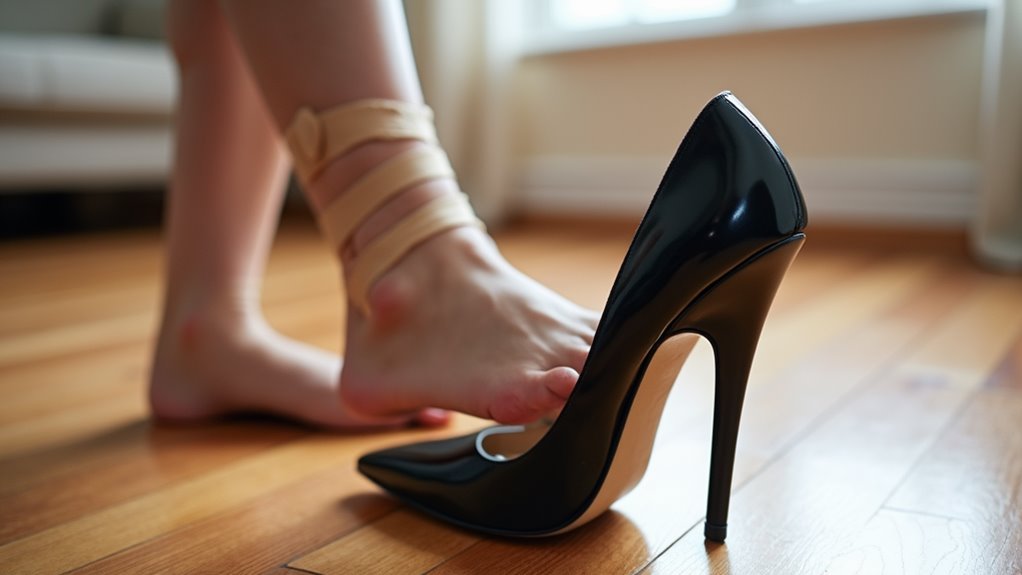There may be products. Products are independently selected by our editors. We may earn an affiliate commission from the links with no charge to you, example: as Amazon Affiliate.
Did you know that wearing high heels for just three hours can temporarily shorten your calf muscles by up to 13%? While you’ve probably experienced discomfort from wearing heels, you might not realize the extent of potential damage these fashionable shoes can cause to your feet, ankles, and entire skeletal system. From micro-tears in ligaments to permanent bone deformities, the risks go far beyond temporary pain. Understanding these dangers and knowing how to prevent them won’t just save your feet – it could protect your long-term mobility and overall health.
Key Takeaways
- Most high heel injuries involve ankle sprains and foot damage due to uneven weight distribution and instability of the footwear.
- High heel-related injuries primarily affect women aged 20-29, with over 80% of accidents occurring at home.
- Regular high heel wear can cause long-term complications including bunions, hammertoes, plantar fasciitis, and chronic back pain.
- Choose heels under 3 inches with wide toe boxes and chunky heels for better stability and reduced injury risk.
- Prevent injuries by limiting wear time, using protective inserts, alternating with comfortable shoes, and performing regular foot exercises.
The Rising Problem
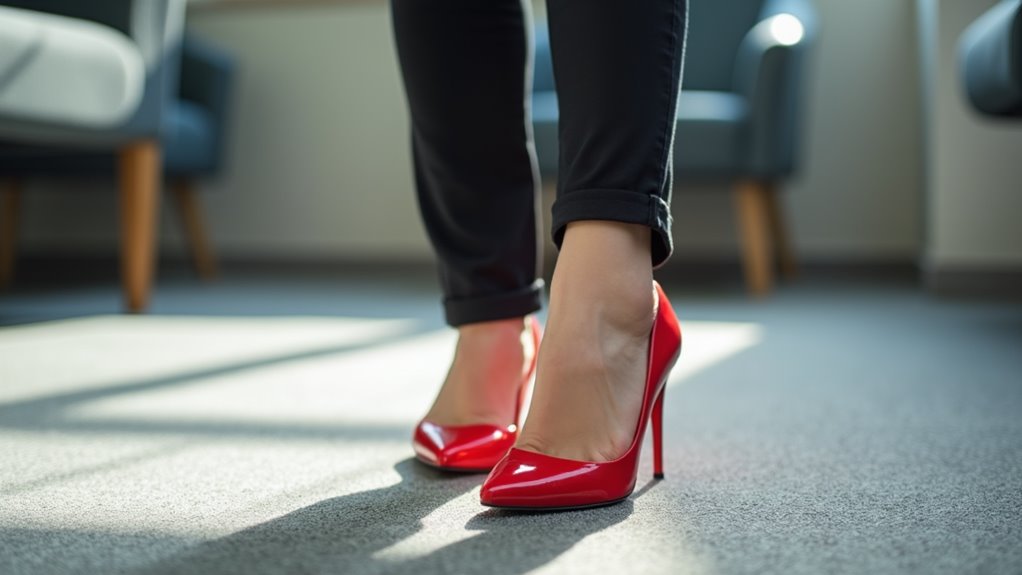
While high heels remain a popular fashion choice, their impact on foot health has become increasingly concerning. When you wear high heels, you’re forcing your feet into an unnatural position that creates uneven weight distribution and stresses the balls of your feet and toes.
You’ll notice that narrow, pointed toe boxes compress your toes, which can lead to painful deformities like hammertoes and bunions. Your risk of ankle sprains increases significantly due to the shoe’s instability and altered walking mechanics.
You’re also more likely to develop conditions like plantar fasciitis from lack of arch support and neuromas from compressed nerves between your toes. These issues don’t just affect your feet – the changed walking pattern can trigger additional problems in your hips, knees, and back. Fortunately, modern comfort-focused heels provide better support while maintaining style.
High Heel Injury Statistics
Recent data paints a troubling picture of high heel-related injuries in the United States. From 2002 to 2012, over 123,000 high heel injuries required emergency treatment, with young women aged 20-29 facing the highest risk.
You’re most likely to suffer an injury at home, where more than 80% of these accidents occur.
The most concerning statistics reveal that:
- Ankle and foot injuries account for more than 80% of all cases
- One in five accidents results in a broken bone
- Summer months see the highest number of incidents
- The injury rate nearly doubled during the studied period
If you wear high heels, you’re particularly vulnerable to sprains, strains, and fractures.
The elevated heel position reduces ankle stability and increases pressure on your feet’s pressure points, making falls and twists more likely.
Most Common Foot Injuries

Despite their fashionable appeal, high heels can lead to numerous foot injuries that range from minor discomfort to severe medical conditions.
You’ll commonly experience heel pain from the formation of “pump bumps” and plantar fasciitis, which causes burning sensations in your heel. Your toes may develop bunions or hammertoes due to cramped toe boxes, while the balls of your feet endure excessive pressure that can result in Morton’s Neuroma.
High heels also put you at risk for sprained ankles and shortened Achilles tendons.
The unnatural weight distribution can cause stress fractures, nerve compression, and chronic arch strain.
You might develop painful corns, calluses, or ingrown toenails from the constant pressure and friction on your feet, particularly in shoes with narrow toe boxes.
Selecting orthopedic footwear options can help prevent these common high heel-related injuries while maintaining professional style.
Ankle and Back Complications
When you wear high heels, your posture shifts dramatically as your body compensates for the unnatural foot position, forcing your pelvis to tilt and your lower back to arch excessively.
Your ankles become particularly vulnerable to twisting injuries since the elevated heel position reduces stability and weakens your ankle’s natural defense mechanisms.
The constant strain on your lower back muscles can lead to chronic pain, muscle fatigue, and potential long-term spinal issues that may require medical intervention.
Posture Changes While Walking
As women step into high heels, their bodies undergo significant biomechanical changes that affect posture from head to toe. You’ll notice your feet point downward while your knees flex more than usual, compromising joint stability.
Your lower back curves increase to compensate for the altered center of gravity, which can trigger back pain and reduce your spine’s shock-absorbing capacity.
- Your step length shortens significantly, and you’ll find it harder to maintain natural balance.
- Your feet’s normal rolling motion becomes restricted, changing how you distribute weight.
- Your ankle position becomes unstable, increasing your risk of sprains.
- Your lower back muscles work overtime to maintain stability, leading to fatigue.
These postural changes don’t just affect how you look – they fundamentally alter your walking mechanics and can lead to long-term complications.
Twisted Ankle Risk Factors
While balancing on high heels, you’re significantly more likely to experience ankle sprains and related complications due to the altered biomechanics of your feet. Your ankles experience greater plantarflexion and inversion angles compared to wearing flat shoes, increasing the risk of lateral sprains.
When you wear high heels, your peroneus longus muscle works harder to stabilize your ankle, leading to muscle fatigue. The uneven pressure distribution can trigger stress fractures, and prolonged use weakens your ankle stability.
You’ll notice your calf muscles becoming tighter, which limits your ankle’s range of motion and flexibility. This combination of factors makes you more susceptible to sudden twists and turns that can result in sprains, especially during physical activities.
Without proper prevention, these issues can develop into chronic problems.
Lower Back Strain Effects
Because high heels dramatically alter your body’s natural alignment, you’ll experience significant strain throughout your lower back region.
When you wear high heels, your body leans forward at the bottom and backward at the top to maintain balance, causing your spine and hips to misalign. This unnatural position puts extra pressure on your spine and can lead to chronic pain or serious injuries over time.
- Your calf muscles and hamstrings tighten, affecting your lower back and pelvis
- You’re at risk for foraminal stenosis, which compresses nerves through narrowed spaces
- Your sciatic nerve may become pinched, causing pain and numbness
- You’ll likely develop muscle dysfunction that can lead to permanent nerve problems
To protect yourself, alternate between heels and flats, and regularly stretch your leg muscles and lower back.
Smart Footwear Choices
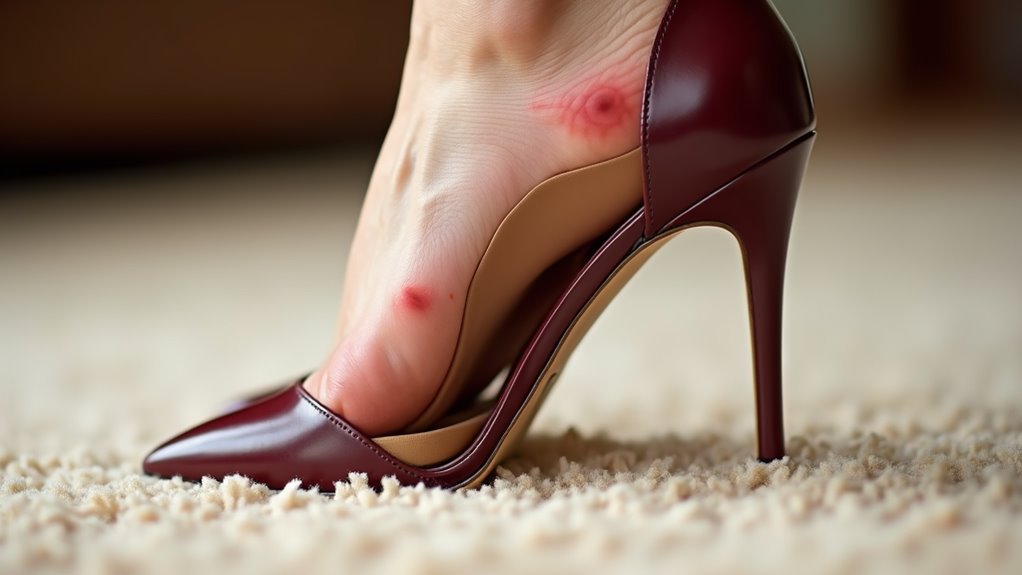
Making informed choices about high heel design and construction can significantly reduce your risk of foot injuries.
When selecting high heels, opt for styles with heels no higher than 3 inches and choose wider toe boxes to prevent toe compression.
You’ll find more stability and comfort with chunky or block heels rather than stilettos.
Look for shoes crafted from high-quality leather, featuring soft leather linings and padded insoles.
These materials will mold to your feet’s shape and provide better flexibility.
Don’t purchase shoes with pointy toes or narrow fits, as they can lead to bunions and other foot problems.
Consider platform heels with shock-absorbing insoles for extra cushioning.
Before wearing your heels out, practice walking in them at home to ensure they’re comfortable and suitable for extended wear.
For maximum comfort throughout the day, consider investing in comfort pump shoes designed specifically for professional wear.
Essential Prevention Methods
Proper prevention techniques can protect your feet from high heel-related injuries and discomfort. You’ll need to focus on essential practices that distribute pressure, support your heels, and maintain foot flexibility.
Start by elevating your heels with specialized devices or cushions when resting, and perform daily stretching exercises for your calves and Achilles tendon.
For maximum comfort and support, consider investing in comfort style heels that provide both style and functionality.
- Use silicone protective sleeves and metatarsal pads to reduce friction and pressure points
- Take regular breaks from high heels and limit wear time to under three hours daily
- Choose shoes with thicker heels and gradual slopes to improve stability
- Practice consistent foot care, including regular massages and mobility exercises
Remember to maintain a consistent heel height and opt for shoes with wider toe boxes to prevent unnecessary strain on your feet.
Medical Treatment Options
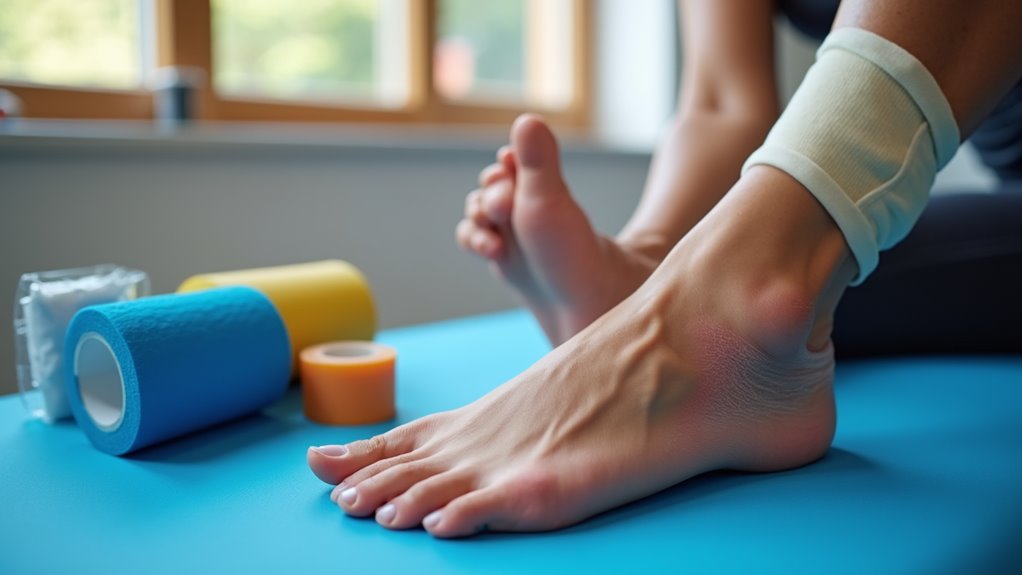
Medical professionals offer several treatment options for high heel-related injuries, ranging from conservative approaches to surgical interventions.
For mild to moderate conditions, you’ll likely start with conservative treatments. These include taking NSAIDs to reduce pain and inflammation, attending physical therapy sessions for stretching exercises, and using ice therapy.
You might also need to modify your footwear or use orthotic devices to provide better support.
If conservative treatments don’t provide relief, your doctor may recommend more aggressive options. These can include steroid injections, extracorporeal shockwave therapy, or surgical procedures.
Surgery might involve removing bone spurs, realigning the heel bone, or addressing tendon issues. After surgery, you’ll need to follow a careful recovery plan, including wearing protective boots and gradually returning to normal activities under professional guidance.
Safe Wearing Guidelines
When wearing high heels, you’ll need to follow specific guidelines to minimize your risk of injury and discomfort. Choose heels that are 2 inches or less in height, and opt for platform styles that help distribute pressure more evenly. For a sophisticated look that prioritizes comfort, consider dark blue suede heels as a versatile option that complements professional attire.
Look for shoes with wider toe boxes and stability features like chunky heels or adjustable closures.
Don’t wear your high heels for more than three hours at a time, and remember to take micro-breaks throughout the day.
Consider alternating between different pairs of shoes and wearing comfortable footwear during your commute.
- Strengthen your lower leg muscles through regular exercises
- Practice walking in heels to improve stability
- Use orthopedic pads for extra cushioning and support
- Ensure proper fit to prevent sliding and toe pressure
Recovery And Physical Therapy
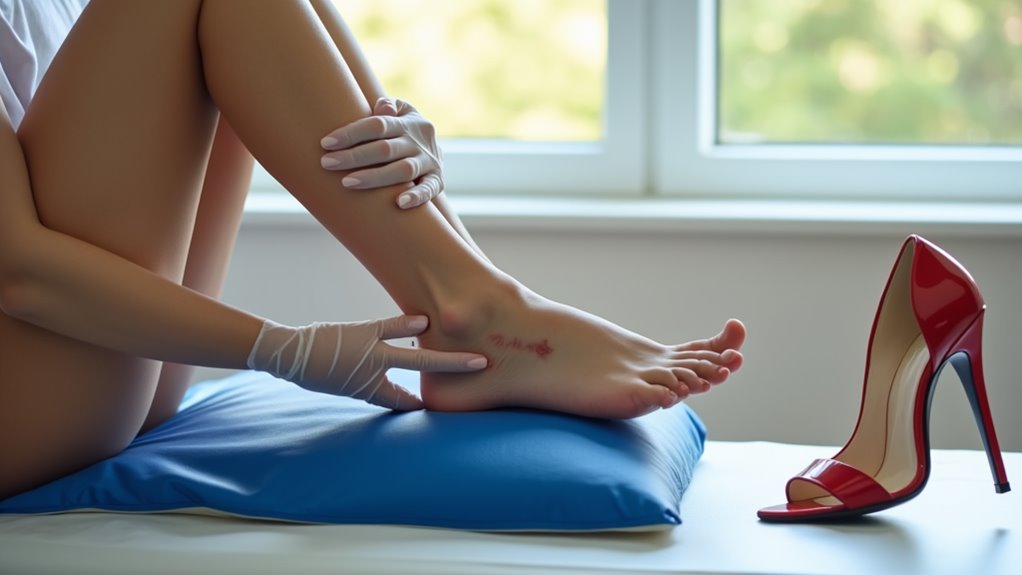
You’ll need to follow key recovery steps after wearing high heels, including soaking your feet, gentle massage, and elevation to reduce inflammation and promote healing.
Your physical therapist can guide you through therapeutic exercises like plantar fascia massage and heel raises to strengthen your feet and prevent future injuries.
To manage long-term effects, you should incorporate daily foot exercises into your routine while following professional guidance on proper footwear and preventive strategies.
For optimal healing and comfort, consider using trusted foot products specifically designed for post-heel wear recovery.
Essential Recovery Steps
Recovering from high heel injuries requires a systematic approach that combines rest, physical therapy, and proper support techniques.
You’ll need to start by avoiding strenuous activities and elevating your foot above heart level to reduce swelling. Apply cold compresses for 15-20 minutes, then switch to heat therapy as healing progresses. For faster recovery, incorporate gentle massage around the injured area to boost circulation.
- Use temporary taping and night splints to maintain proper foot alignment
- Perform targeted stretching exercises to improve flexibility
- Wear supportive footwear with cushioned inserts or orthotics
- Consider consulting a physical therapist for a personalized treatment plan
Remember to address your injury early and follow through with rehabilitation exercises to prevent long-term complications and ensure proper healing.
Therapeutic Exercise Programs
A comprehensive therapeutic exercise program forms the foundation of recovery from high heel injuries.
You’ll need to focus on both stretching and strengthening exercises to restore foot health. Start with gentle calf stretches against a wall and towel stretches to improve flexibility. Roll your foot on a frozen water bottle to reduce inflammation while massaging tired muscles.
For strength building, practice ankle circles and toe yoga to enhance muscle control. You can also incorporate step-ups and short foot exercises to improve stability.
Don’t forget to complement these exercises with proper physical therapy techniques, including ice therapy and custom orthotics if needed. To maintain progress, wear flexible, supportive footwear and elevate your feet regularly.
Consider consulting a podiatrist for personalized guidance on your recovery journey.
Managing Long-Term Effects
When managing long-term effects of high heel injuries, it’s crucial to develop a comprehensive recovery strategy that addresses both immediate symptoms and potential chronic conditions.
You’ll need to work with healthcare professionals who can assess your condition and create a tailored treatment plan. This may include physical therapy, custom orthotics, and lifestyle modifications to prevent further damage.
- Switch between high heels and supportive flat shoes to reduce continuous pressure on your feet
- Use orthotic supports and cushioning to distribute weight evenly
- Engage in regular stretching and strengthening exercises for your feet, ankles, and back
- Monitor your body for signs of chronic conditions and seek professional help when needed
Consider consulting multiple specialists, including podiatrists, chiropractors, and physical therapists, to ensure you’re receiving comprehensive care for your specific needs.
Long Term Health Effects
Regular high heel wear inflicts lasting damage on your body’s structure and function, affecting everything from your feet to your spine. You’ll experience chronic muscle shortening in your legs, leading to reduced mobility and increased injury risk. Your tendons become inflamed and weakened, while your natural gait changes even when you’re not wearing heels.
| Body Area | Primary Effects | Long-Term Impact |
|---|---|---|
| Feet | Bunions, Metatarsalgia | Chronic Pain |
| Legs | Muscle Shortening | Limited Mobility |
| Spine | Posture Changes | Back Problems |
The cumulative effects extend beyond musculoskeletal issues. You’ll face potential circulatory problems like varicose veins from restricted blood flow. Your digestive system may become dysregulated due to altered posture, and you’ll likely develop chronic foot fatigue and plantar fasciitis. These conditions often persist even after you stop wearing high heels. Consider switching to sustainable heels that provide better support while minimizing environmental impact.
Conclusion
Like Cinderella’s glass slippers, your high heels shouldn’t become instruments of torture. You’ll find that making informed choices about heel height and wear time can prevent you from becoming your own wicked stepmother to your feet. Don’t let vanity override comfort – implement these prevention tips, seek proper treatment when needed, and you’ll dance gracefully through life without devastating foot complications.

